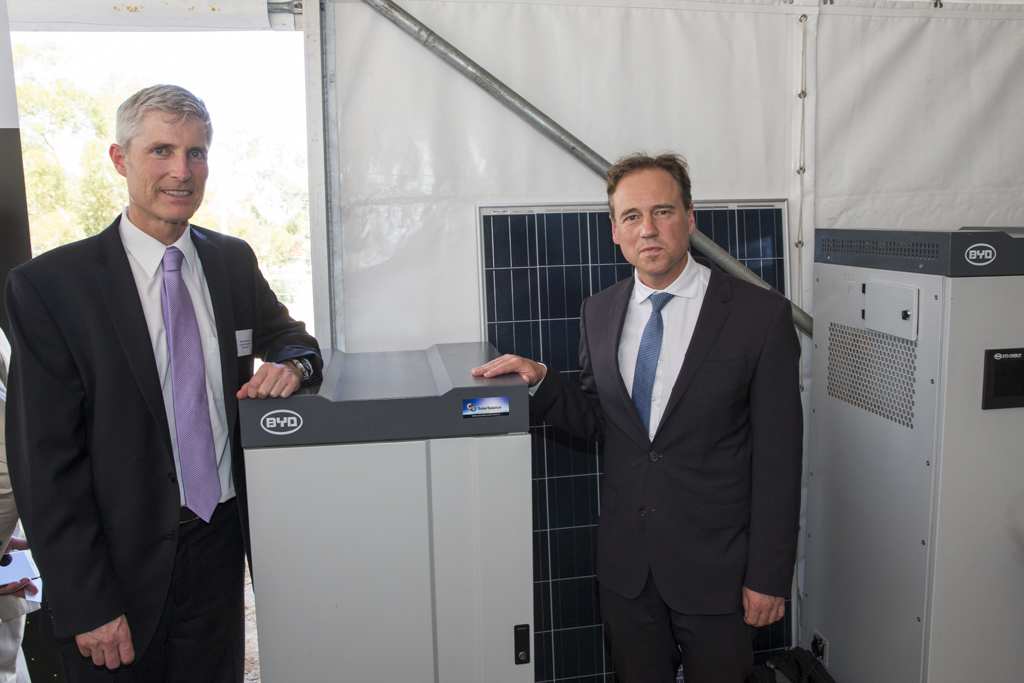Environment minister Greg Hunt says he wants Australia to lead the world in battery storage, in the same way as it has done so in rooftop solar.
“Solar and storage together are the future of electricity,” Hunt said during a whirlwind visit to two battery storage trials at new residential communities in Western Australia. “That’s a huge direction in Australia and we are the world’s leading household solar nation.
“Now we want to be number one in the deployment of battery storage. That will take time but this project again puts Australia right at the forefront.”
Hunt spoke as he visited Alkimos, north of Perth, where the local utilities have combined with developer Lend Lease to install a 1.1MWh battery storage unit to see how that can lower grid costs, help integrate solar and other renewables, and cut costs for consumers.
 He also visited White Gum Valley (picture right) where another new home development will use solar and individual battery storage units – a total of 300kWh – to enable the residents of 80 new apartments to generate their own power, store it and share it, as well as charge shared electric vehicles.
He also visited White Gum Valley (picture right) where another new home development will use solar and individual battery storage units – a total of 300kWh – to enable the residents of 80 new apartments to generate their own power, store it and share it, as well as charge shared electric vehicles.
Hunt then announced government support for four other battery storage trials as part of $17 million of R&D grants that will focus on the integration of renewable energy, and rooftop solar in particular. These include Burny Island i Tasmania
This is not the first time that Hunt has enthused about battery storage. Last year he suggested that it was “inevitable” that many people would leave the grid because of the changing economics of the energy system, and the plunging cost of solar and battery storage.
These new developments are all about staying connected to the grid, but finding an avenue that limits grid costs by reducing the network investment. If local communities can manage a large part of their own demand, then they don’t need as big or costly a grid connection.
This opportunity is now dawning on politicians of all stripes, and the utilities, even if it is not yet clear how smoothly this transition will occur, with many still tempted by the cash flows of incumbent businesses and regulators moving at a snail’s pace.
Hunt, though, was adamant that battery storage was the future, particularly for individual households with solar on the rooftops.
“It’s about reducing the costs for the grid, reducing the costs for household and giving people the opportunity to control their own energy use,” Hunt said.
Equally enthusiastic was WA energy minister Mike Nahan, a recent convert to the distributed energy revolution who sees solar and storage as a way that the state can reduce its crippling subsidies that has supported a fossil-fuel based, centralised energy system.
“This is an important advancement in that the world is changing very rapidly,” Nahan said, noting that the ARENA support for the Alkimos trial – a total of $3.3 million out of a total budget of $6.7 million – amounted to a subsidy of $45,000 per household.
“We expect this to come down and we will learn many things,” Nahan said. “Like how to integrate, how to incentivise houses, how to get the tariffs right, so that when battery technology does come down to a lower level, which it is doing now, it becomes mainstream and we can integrate it not only in new dwelling suburbs like this but across old suburbs.”
Indeed, $45,000 sounds like a scary number, but as ARENA CEO Ivor Frischknecht pointed out, this is a first of its type battery storage installation, and it is over and above the cost of the grid, which in future projects will be downsized in new developments once the performance of this installation is understood.
Synergy CEO Jason Waters said the savings for consumers would be around 20 per cent from their bills without solar and storage. This saving was being supported by the ARENA grant, but once costs had come down and the added expense of a first-of-its-type installation removed, then those savings should be constant.
Savings are also on offer in White Gum Valley, where residents will generate their own solar, store it, share it and trade with neighbours through peer-to-peer trading, and also use it to power electric vehicles.
Waters says that Synergy has created a special tariff for the Alkimos trial, which involves a storage fee where residents who wish to spill and have their energy stored into the battery pay a small monthly fee.
“For that they earn credits for the power that they spill into the grid, which is offset against their consumption at peak times when their household demand exceeds that of the battery,” Waters said.
“So by our assessment if the residents are mindful of their consumption, use the technology that they have available to them in each of the households here at Alkimos, which is a very high-tech suburb from an energy management perspective, there is real savings available to consumers, potentially as much as twenty per cent on an annual basis.”
ARENA CEO Ivor Frischknecht said new developments like Alkimos will likely need a small connection to the grid. “That means lower cost for the people who are buying new lots, less investment in poles and wires and transformers.
“It also means that you could potentially on a peak day when it’s really hot, everybody’s running their air conditioners, it means that you might be able to rely on the energy that’s stored in the battery instead of building more poles and wires and power stations elsewhere.”












